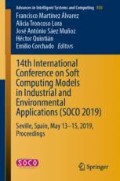Abstract
In this study, the fall detection method is carried out as stated on [1, 11]; a simple finite state machine is used to process acceleration data in sliding windows and whenever a fall-like event is found, features are extracted from this data. Using some clustering and classification algorithms described here, the event is classified as FALL or NOT_FALL. This research evaluates the performance of different proposed clustering and classification methods. It makes use of a new dataset, with data gathered by a wearable device placed on the wrist and used by several members of the research team and an emergency rescue training manikin under different fall scenarios to simulate the falls. A 10-fold cross-validation is also made to evaluate these methods on unseen data.
Access this chapter
Tax calculation will be finalised at checkout
Purchases are for personal use only
References
Abbate, S., Avvenuti, M., Bonatesta, F., Cola, G., Corsini, P.: AlessioVecchio: a smartphone-based fall detection system. Pervasive Mobile Comput. 8(6), 883–899 (2012)
Abbate, S., Avvenuti, M., Corsini, P., Light, J., Vecchio, A.: Monitoring of human movements for fall detection and activities recognition in elderly care using wireless sensor network: a survey. In: Wireless Sensor Networks: Application - Centric Design, p. 22. Intech (2010)
Bourke, A., O’Brien, J., Lyons, G.: Evaluation of a threshold-based triaxial accelerometer fall detection algorithm. Gait Posture 26, 194–199 (2007)
Delahoz, Y.S., Labrador, M.A.: Survey on fall detection and fall prevention using wearable and external sensors. Sensors 14(10), 19806–19842 (2014). http://www.mdpi.com/1424-8220/14/10/19806/htm
Fang, Y.C., Dzeng, R.J.: A smartphone-based detection of fall portents for construction workers. Procedia Eng. 85, 147–156 (2014)
Fang, Y.C., Dzeng, R.J.: Accelerometer-based fall-portent detection algorithm for construction tiling operation. Autom. Constr. 84, 214–230 (2017)
Hakim, A., Huq, M.S., Shanta, S., Ibrahim, B.: Smartphone based data mining for fall detection: analysis and design. Procedia Comput. Sci. 105, 46–51 (2017). http://www.sciencedirect.com/science/article/pii/S1877050917302065
Huynh, Q.T., Nguyen, U.D., Irazabal, L.B., Ghassemian, N., Tran, B.Q.: Optimization of an accelerometer and gyroscope-based fall detection algorithm. J. Sens. 2015, 8 (2015)
Igual, R., Medrano, C., Plaza, I.: Challenges, issues and trends in fall detection systems. Biomed. Eng. Online 12, 66 (2013). http://www.biomedical-engineering-online.com/content/12/1/66
Kangas, M., Konttila, A., Lindgren, P., Winblad, I., Jämsaä, T.: Comparison of low-complexity fall detection algorithms for body attached accelerometers. Gait Posture 28, 285–291 (2008)
Khojasteh, S.B., Villar, J.R., Chira, C., Gonzalez, V.M., de la Cal, E.: Improving fall detection using an on-wrist wearable accelerometer. Sensors 18(5), 1350 (2018)
Khojasteh, S.B., Villar, J.R., Chira, C., González, V.M., de la Cal, E.: Improving fall detection using an on-wrist wearable accelerometer. Sensors 18, 1–20 (2018)
Meyer, D., et al.: Probability Theory Group (Formerly: E1071), TU Wien - Package ’e1071’ (2019). https://cran.r-project.org/web/packages/e1071/e1071.pdf
Purch.com: Top ten reviews for fall detection of seniors (2018). www.toptenreviews.com/health/senior-care/best-fall-detection-sensors/
R Core Team and contributors: K-means clustering in R stats package (2019). https://stat.ethz.ch/R-manual/R-devel/library/stats/html/kmeans.html
Ripley, B., Venables, W.: Functions for classification - package ‘class’ (2019). https://cran.r-project.org/web/packages/class/class.pdf
Khojasteh, S.B., Villar, J.R., de la Cal, E., González, V.M., Sedano, J., Yazg̈an, H.R.: Evaluation of a wrist-based wearable fall detection method. In: 13th International Conference on Soft Computing Models in Industrial and Environmental Applications, pp. 377–386 (2018)
Wu, F., Zhao, H., Zhao, Y., Zhong, H.: Development of a wearable-sensor-based fall detection system. Int. J. Telemed. Appl. (2015). https://www.hindawi.com/journals/ijta/2015/576364/
Zhang, S., Wei, Z., Nie, J., Huang, L., Wang, S., Li, Z.: A review on human activity recognition using vision-based method. J. Healthc. Eng. 2017, 31 (2017)
Zhang, T., Wang, J., Xu, L., Liu, P.: Fall detection by wearable sensor and one-class svm algorithm. In: Huang DS., Li K., I.G. (ed.) Intelligent Computing in Signal Processing and Pattern Recognition, Lecture Notes in Control and Information Systems, vol. 345, pp. 858–863. Springer Berlin Heidelberg (2006)
Acknowledgment
This research has been funded by the Spanish Ministry of Science and Innovation, under project MINECO-TIN2017-84804-R.
Author information
Authors and Affiliations
Corresponding author
Editor information
Editors and Affiliations
Rights and permissions
Copyright information
© 2020 Springer Nature Switzerland AG
About this paper
Cite this paper
Fáñez, M., Villar, J.R., de la Cal, E., González, V.M., Sedano, J. (2020). Feature Clustering to Improve Fall Detection: A Preliminary Study. In: Martínez Álvarez, F., Troncoso Lora, A., Sáez Muñoz, J., Quintián, H., Corchado, E. (eds) 14th International Conference on Soft Computing Models in Industrial and Environmental Applications (SOCO 2019). SOCO 2019. Advances in Intelligent Systems and Computing, vol 950. Springer, Cham. https://doi.org/10.1007/978-3-030-20055-8_21
Download citation
DOI: https://doi.org/10.1007/978-3-030-20055-8_21
Published:
Publisher Name: Springer, Cham
Print ISBN: 978-3-030-20054-1
Online ISBN: 978-3-030-20055-8
eBook Packages: Intelligent Technologies and RoboticsIntelligent Technologies and Robotics (R0)

